Tips for Viewing MARS at Maximum Size, the Waning Moon Rides the Bull, and the Dragon Spits Stars!

This amazing image of Mars was taken on October 2, 2020 at 11:13 EDT by my friend Claudio Oriani of Richmond Hill, Ontario through his Celestron C8 SCT and a ZWO AS1224MC camera. The southern polar cap and the dark Syrtis Major regions are obvious.
Hello, October Stargazers!
Here are your Astronomy Skylights for the week of October 4th, 2020 by Chris Vaughan. Feel free to pass this along to your friends and send me your comments, questions, and suggested topics. You can also follow me on Twitter as @astrogeoguy! Unless otherwise noted, all times are expressed in Eastern Time. To subscribe to these emails please click this MailChimp link.
I can bring my Digital Starlab portable inflatable planetarium to your school or other daytime or evening event, or teach a session online. Contact me through AstroGeo.ca, and we’ll tour the Universe, or the Earth’s interior, together!
This week and next offer your chance to view Mars at its long-awaited close opposition. The moon will leave the evening scene as it passes last quarter. Meanwhile, the bright planets Jupiter and Saturn will persist in early evening, and Venus will gleam in the pre-dawn. Keep an eye out for meteors, too! Here are your Skylights!
Mars
After months of waiting, Mars will take centre stage this week! On Monday night, and into Tuesday morning, the Red Planet will be closer to Earth than at any time until 2035. That means that virtually any size of telescope will be able to show you Mars’ ruddy disk – and perhaps some surface markings! The media will talk about Mars next week, at opposition. But while Mars will be ever-so-slightly brighter then, it won’t look as large as it will during the next few nights! In other words, take advantage of every clear night this week to see Mars – don’t wait!
Let’s break down exactly why all this is happening. Mars has an orbit that is about 50% farther from the sun than Earth’s, on average. That causes Earth to complete an orbit of the sun more quickly than Mars does. In fact, Earth circles the sun almost twice in the time Mars takes to complete one orbit. If the planets were placed at the same starting line on an imaginary racetrack around the sun (as they will be next Tuesday, at opposition), when Earth returned after one lap, slowpoke Mars would be out of sight on the opposite side of the sun. When Earth has completed its second lap, Mars would be back on the same side of the sun, and a bit ahead of us along the track. To be precise, Earth passes Mars every 2 years and 50 days.

There’s an extra twist to all this. Our orbit is fairly circular, while Mars’ orbit is much more elliptical. Its distance from the sun varies quite a bit – between 206.7 million km and 249.2 million km, or about 20%. Every 15 years or so, the geometry works out that we pass Mars while we are near aphelion (our maximum distance from the sun) and Mars is near perihelion (its minimum distance from the sun). When that happens, our two planets are at their minimum separation from one another. That happened in July, 2018. This month’s encounter is the second closest. We will not be this close to Mars again until 2035 – when Mars will be near its perihelion point when they align.
This year, Earth and Mars are meeting about two months after Mars was at perihelion. Right now the two planets are positioned in the zone where the distance between their orbits is widening. For that reason, Mars will be closest to Earth on October 5-6, but it will be aligned with the Earth at opposition, a full week later.
During the early hours of Tuesday, October 6, Earth and Mars will be only 62.07 million km, 0.515 Astronomical Units (1 A.U. is the mean Earth-sun distance), or 3.45 light-minutes distant from Earth. Viewed in a telescope Mars’ maximum apparent disk diameter will be 22.6 arc-seconds. (For comparison, Jupiter’s disk spans about 44 arc-seconds.) At opposition on October 13, Mars will be 62.7 million km, or 0.419 AU, or 3.49 light-minutes away from Earth. A year from now, Mars will be on the far side of the sun from us – a distance of 393 million km, 2.63 AU, or 21.85 light-minutes! It’s clear why we send spacecraft to Mars around oppositions!
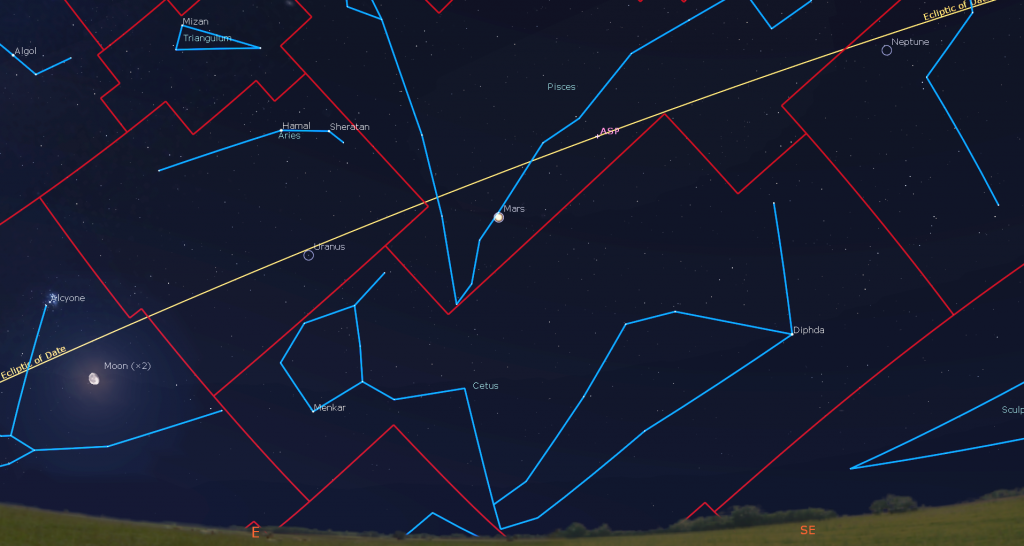
Let’s talk about viewing Mars. It’s already brighter than Jupiter. This week, the very bright, reddish-tinted planet will be rising in the east before 7:30 pm in your local time zone. It will reach more than a third of the way up the southeastern sky by late evening, then it will climb to slightly more than half-way up the southern sky by 2 am local time, and set in the west after sunrise. Because Earth is passing it now, Mars is moving retrograde, causing the planet to appear to travel backwards (westwards) compared to the narrow “V” of modest stars at the bottom of the constellation of Pisces (the Fishes). But you won’t see that motion, unless you carefully note its position every night.
In good binoculars you might be able to discern Mars’ little round disk– but if you can get your hands on any sized telescope, you’ll see much more! Because Mars’ rotational period (its day) is about 38 minutes longer than Earth’s, by viewing the planet over many nights you can see different parts of Mars’ surface. In fact, it would take you 41 nights of observing to see the entire globe of Mars. But since we have about 10 hours of darkness during nights in early October, you could check in on the planet between 9 pm and 6 am local time, and see almost half of its globe within a single night!

Mars’ Earth-facing hemisphere on October 5-6 will display its bright southern polar cap, the very dark Syrtis Major Planum, Tyrrhena Terra, and Sinus Sibaeus regions, and the lighter toned Hellas Planitia region.That view will remain about the same all week. I’ll post a labelled Mars map here. (Don’t forget that your telescope will probably flip Mars upside-down and/or mirror it left-to-right.) Owners of larger telescopes could also try to see Mars’ two small moons, Phobos and Deimos.
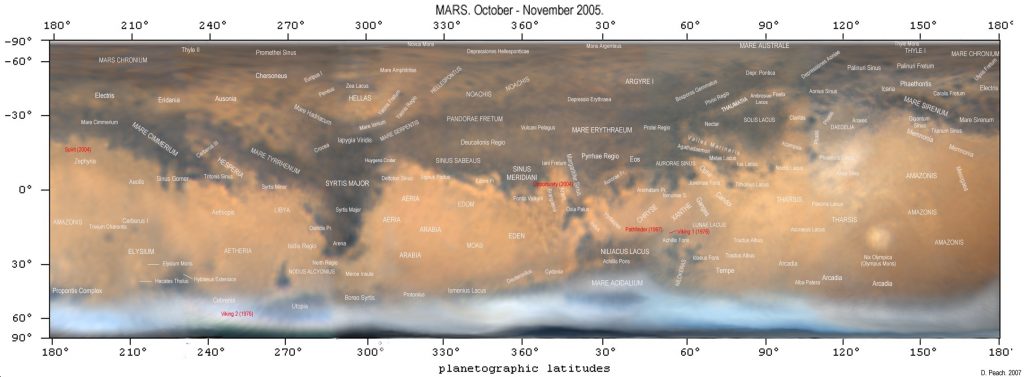
When viewing anything in a telescope, be patient. Look continuously, and wait for the moments of sharp clarity when the air settles down. The coloured filters that come with some telescopes and eyepiece kits can enhance Mars, as follows: #23A Light Red – Dust clouds on Mars, #25 Red – Ice caps and surface of Mars, #47 Violet – clouds on Mars, #56 Light Green – Mars ice caps, and #58 Green – Martian ice caps, clouds, and dust storms. If you find Mars is too bright in your telescope, try using a moon filter to reduce the glare, or reduce the telescope’s aperture by using the moon lens cap that most telescopes come with.
After opposition, Mars will steadily diminish in both brightness and apparent disk size – but it will also become better placed for evening observing. At mid-northern latitudes, the planet’s maximum height above the southern horizon will occur several hours earlier than in early October – and much higher than at its previous opposition in 2018.
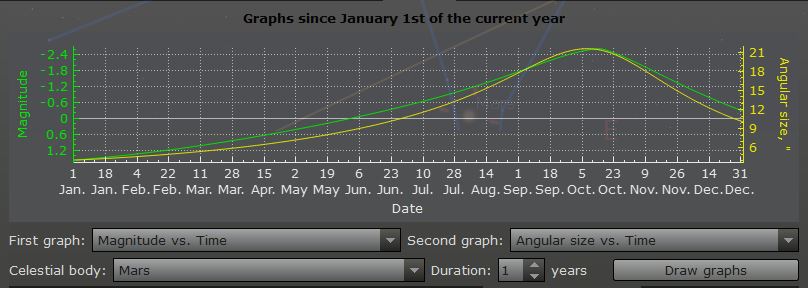
I’ll talk a bit more about Mars opposition next week. In the meantime – head outside and take a good look!
Draconids Meteor Shower Peaks
The Draconids Meteor Shower, which runs between October 6 and 10 every year, will peak overnight on Wednesday, October 7. This shower, generated by debris dropped by Comet 21P/Giacobini-Zinner, usually delivers relatively few meteors. But it has occasionally been much more prolific. The best time to watch for Draconids will be after dusk, when the shower’s radiant in Draco (the Dragon) will be sitting high in the northern sky. Unfortunately, a bright, waxing gibbous moon will wash out many of the fainter meteors after 10 pm local time.
You can also watch for Orionids meteors. Those ones will appear to be travelling away from the constellation of Orion (the Hunter). That shower is slowly ramping up towards its peak night on October 21.
The Moon Rides the Bull
Now that it has passed its full phase, the moon will be waning and rising later every night – leaving early evening skies moonless and darker for skywatchers all over the world. From Monday to Wednesday, the moon will cross through Taurus (the Bull). Look for the bright, little Pleiades star cluster sitting a palm’s width to the upper left (or 7° to the celestial north) of the moon on Monday night. Those stars are beautiful in binoculars.
On Tuesday night, the moon will land just to the left (northeast) of the bright orange star Aldebaran, the baleful eye of the angry bull. Use your binoculars to see the large, triangular grouping of stars extending to the upper right of Aldebaran. Those stars, which form the face of the bull, are an open star cluster called the Hyades. They are all stellar siblings located about 150 light-years from our solar system – except Aldebaran, which is half as far away.

Taurus is tilted sideways with his chin up to the right (west) and his horns down to the left (east). On Wednesday night, the moon will shift to sit only two finger widths above (or 2° to the celestial north) of the medium-bright star named Zeta Tauri or (ζ) Tau. (Zeta would correspond to the letter “f” in our alphabet.) That magnitude 2.95 star marks tip of the southerly horn of Taurus. The famous Crab Nebula supernova remnant, also known as Messier 1, will be located about midway between the moon and that star. Take note of its location and then try to see Messier 1’s faint little cloud on a very dark night this winter, when Taurus will be high in the evening sky. By the way, Taurus’ northern horn tip is marked by a much brighter star named Elnath, which sits a generous palm’s width to the upper left (or 8° to the north) of Zeta.
On Thursday and Friday, the moon will traverse Gemini (the Twins). When it reaches its last quarter phase at 8:39 pm EDT on Friday, October 9 (or 0:39 GMT on Saturday, October 10), the moon will rise around midnight and then remain visible in the southern sky all morning. At last quarter, the moon is illuminated on its western side, towards the pre-dawn sun. The week of moonless evening skies that follow last quarter are the best ones for observing October’s deep sky targets. And, if you’re morning person, grab your binoculars or telescope and enjoy the spectacularly terrain along the moon’s pole-to-pole terminator – either before dawn, or during the morning daytime. (A polarized filter or a pair of 3D glasses from the movies will increase contrast on a daytime view of the moon. Rotate them until the sky darkens.) Be sure to avoid aiming optics anywhere near the sun!
When the waning crescent moon rises at about 1 am local time on Sunday, October 11, it will be positioned four finger widths above (or 4° to the celestial west) of the large open star cluster known as the Beehive Cluster or Messier 44, in Cancer (the Crab). During the hours before dawn, the moon’s orbital motion will carry it somewhat closer to the cluster. To see Messier 44’s stars more easily, hide the moon just above your binoculars’ field of view.
The Planets (except Mars)
My goodness – sunset is early nowadays! This week in the Greater Toronto Area, the sun will disappear below the western horizon at about 6:45 pm local time, and two minutes earlier each night. Sunset time depends on your latitude. If you live closer to the equator, your sunset will be shifted toward 7 pm. In the far north, the sun will set before 6 pm.
Not long after 7 pm local time, very bright, white Jupiter will pop into view in the lower part of the southern sky. A short time after that, dimmer, yellowish Saturn will appear nearby – sitting a generous palm’s width to Jupiter’s left (east). Our window of opportunity for clear views of those two planets is starting to close. After 10 pm local time, they will be low in the southwestern sky, and shining through a much thicker blanket of Earth’s atmosphere – you might even see them twinkle! Thankfully, the earlier sunsets are providing us more viewing time.
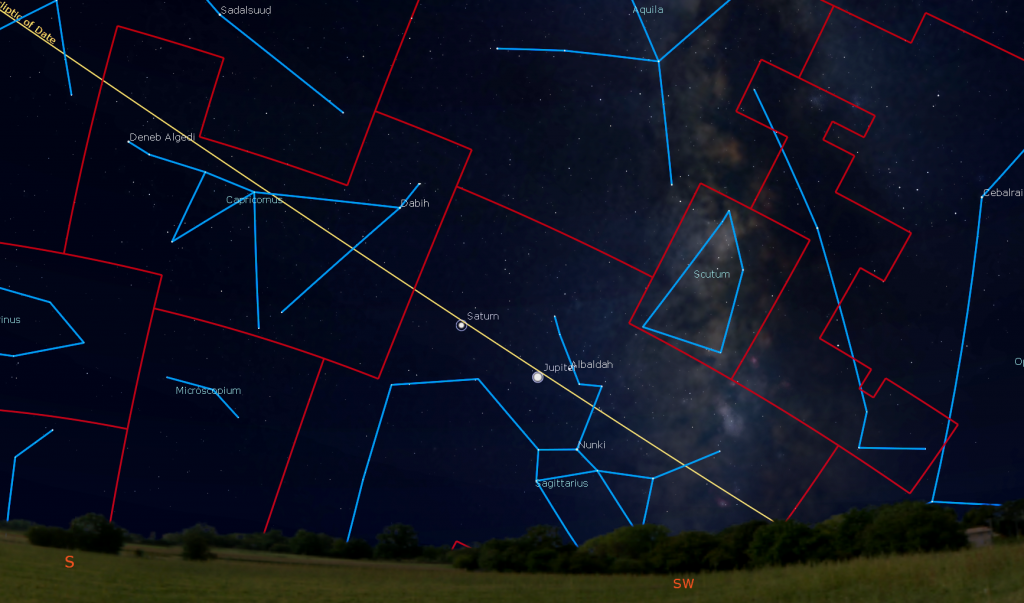
Good binoculars will reveal Jupiter’s four large Galilean moons named Io, Europa, Ganymede, and Callisto as they dance around the planet from night to night. Even a modest-sized telescope will show Jupiter’s brown equatorial belts and the famous Great Red Spot (or GRS, for short) – if the air is steady. Due to Jupiter’s 10-hour period of rotation, the GRS will appear every second or third night at your location on Earth. In the Eastern Time zone, the Great Red Spot will be crossing the planet’s disk after dusk tonight (Sunday), Wednesday, and Friday. It will be visible during late evening on Tuesday and next Sunday.
From time to time, the round, black shadows cast onto Jupiter by its Galilean moons are visible in amateur telescopes as they cross (or transit) the planet’s disk for a few hours. On Thursday, October 8 from 9:02 to 11:19 pm EDT, Io’s shadow will be traveling across Jupiter. These events will be visible anywhere on Earth where Jupiter is above the horizon during the time windows (adjusted to your local time zone). Other places will see different transits.
Saturn is a spectacular sight in any backyard telescope. Even a small one will show you Saturn’s rings. In a telescope, the rings are almost as almost as wide as Jupiter’s disk. See if you can see the Cassini Division. It’s the narrow, dark gap that separates Saturn’s main inner ring from its outer one. From now until December 21, Jupiter will decrease its distance from slower-moving Saturn!
Your telescope should also reveal several of Saturn’s moons – especially its largest, brightest moon, Titan! Because Saturn’s axis of rotation is tipped about 27° from vertical (a bit more than Earth’s axis), we are seeing the top surface of its rings – and its moons can arrange themselves above, below, or to either side of the planet. The trick for seeing more moons is to watch continuously for a minute or two, and let the dimmer, closer-in moons appear whenever the air stabilizes. During evening this week, Titan will migrate counter-clockwise around Saturn, moving from the upper left of Saturn tonight (Sunday) to below the planet next Sunday. (Remember that your telescope might flip the view around.) Fun fact: There’s a Lake Ontario on Titan!
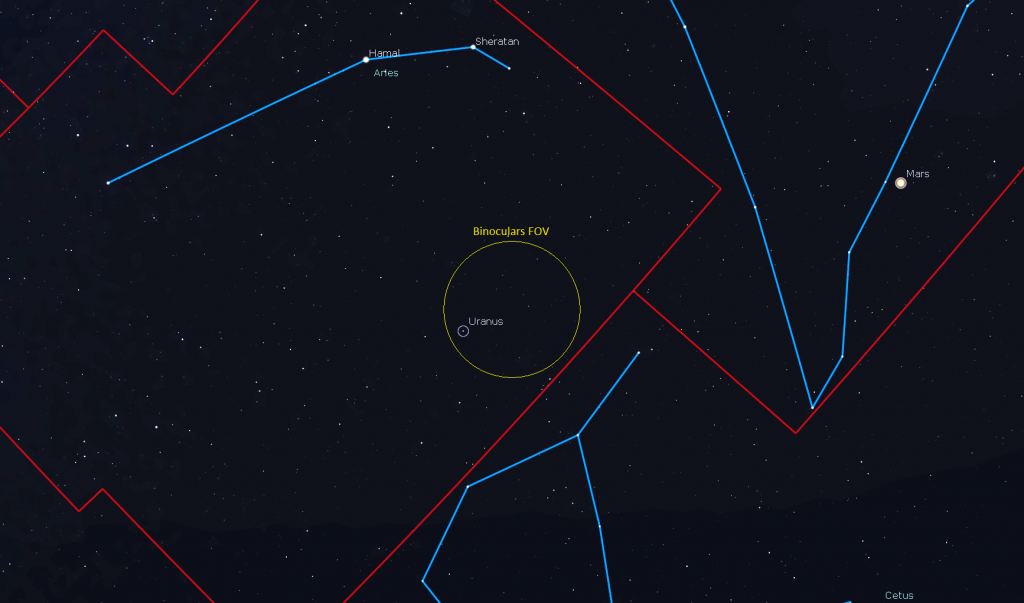
After 8 pm local time worldwide, Mars and the ice giant planets Uranus and Neptune will be above the horizon, too. This week’s moonless evening sky will be ideal for viewing them. Blue-green Uranus will cross the sky all night among the stars of southern Aries (the Ram). It is located a fist’s diameter below and between Aries’ two brightest stars Hamal and Sheratan, and 1.6 fist diameters to the lower left (or 16° to the celestial east) of much brighter Mars. Try for Uranus after 10 pm, when it will be higher in the sky.
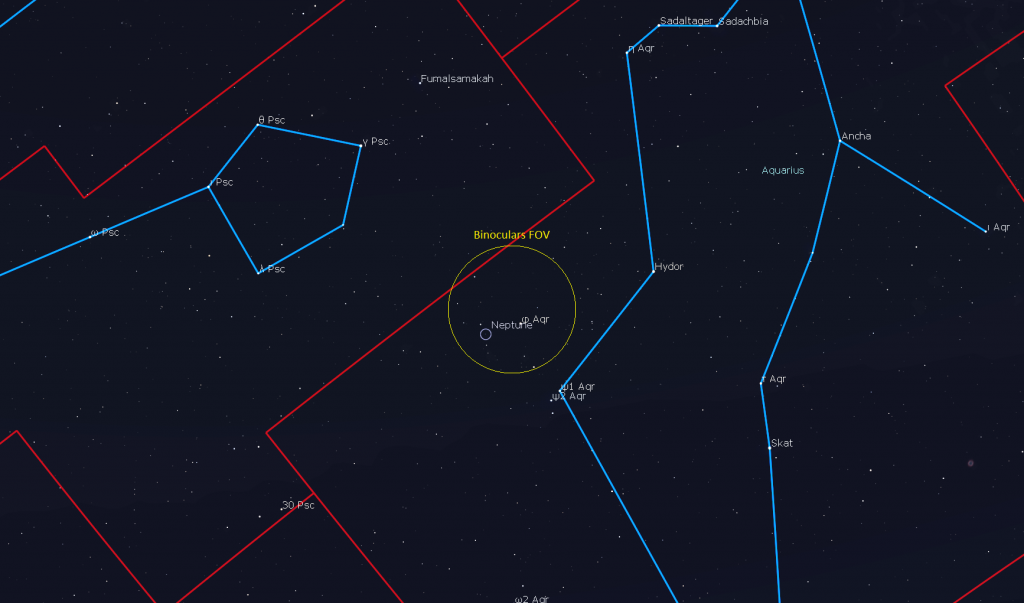
Neptune, which rises in late afternoon, is located among the stars of northeastern Aquarius (the Water-Bearer), about two degrees to the left (or celestial east) of the medium-bright star Phi Aquarii or (φ) Aqr. This week, Neptune will already be in the lower southeastern sky after dusk. Then it will climb higher until 11:30 pm local time, when you’ll get your clearest view of it while it’s halfway up the southern sky.
Venus has been gleaming in the eastern pre-dawn sky for some time now. It will rise at about 4 am local time this week, and then remain visible in the eastern sky until sunrise while it is carried higher by the rotation of the Earth. Viewed in a backyard telescope, Venus will show a gibbous, half-illuminated shape. This week, the planet will be passing through Leo (the Lion) – descending below Leo’s bright, white star Regulus.

Venus is shifting towards the sun – but the later sunrises at this time of year will allow it to shine in a dark, pre-dawn sky until early December! And while you’re up early, enjoy a view of the extremely bright star Sirius, and the winter constellation of Orion (the Hunter) sitting well off to Venus’ upper right.
Bright Baubles in the Night Sky
If you missed my discussion about bright objects they see in the night sky last week, I posted it here.
Public Astro-Themed Events
Mars-themed events will fill the next 10 days – but not everything will be Martian. Here are some highlights!
On Monday night, October 5 from 7 to 8 pm EDT, theoretical astrophysicist Katie Mack will talk with Canadian cosmologist and PhD candidate Sophia Gad-Nasr about Dr. Mack’s new book The End of Everything – giving us a front row seat as they guide us towards that great big unknown. More details are here, and registration for this free public talk, sponsored by the Toronto Public Library, is here.
My free, family-friendly Insider’s Guide to the Galaxy webcasts with Jenna Hinds of RASC National will return on Tuesday, October 6, when we’ll celebrate Mars’ closest approach to Earth until 2035! You can find more details, and the schedule of future sessions, here and here. Don’t forget that Jenna and John Reid also stream on alternate Thursdays at 3:30 pm EDT as they progress through the RASC’s Explore the Universe certificate program.
On Tuesday evening, October 6 from 8 to 10 pm EDT, York University’s Allan I. Carswell Observatory will run a free viewing party called Journey to Mars. If the weather is clear, tune in to YouTube for live images and Mars info from their students and volunteers. Details are here, and the stream will be here.
The Canadian organization Discover the Universe is offering astronomy broadcasts via their website here, and their YouTube channel here.
On many evenings, the University of Toronto’s Dunlap Institute is delivering live broadcasts. The streams can be watched live, or later on their YouTube channel here.
The Perimeter Institute in Waterloo, Ontario has a library of videos from their past public lectures. Their Lectures on Demand page is here.
Keep looking up, and enjoy the sky when you do. I love questions and requests. Send me some!